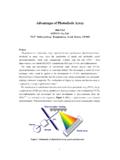Transcription of The new generation of KARL STORZ Video …
1 EndoWorld AN 9-6-E/04-2011C-MAC The new generation of KARL STORZ Video Laryngoscopes:BOEDEKER-D RGES Video LaryngoscopesNew ! D-BLADENew ! C-CAM 10 Years Anniversary MACINTOSH Video Laryngoscope 2 3 C-MAC The new generation of KARL STORZ Video Laryngoscopes:BOEDEKER-D RGES Video LaryngoscopesWhen KARL STORZ , one of the first companies to manufacture Video laryngoscopes, decides to continue its highly successful DCI Video intubation product family with the 4th generation of Video laryngoscopes, customers can rest assured that this will involve more than just superficial updates to the existing chip technology. The most distinguishing feature of the latest generation of C-MAC Video laryngoscopes, developed in collaboration with Prof. Berci, is the consistent implementation of a variety of factors, which have come to be viewed as key customer requirements.
2 The fastest possible access to the system in emergencies A Video image of outstanding quality in the homogenously illuminated oropharynx No fogging of the laryngoscope Optimized battery power with extremely low weight and small dimensions Realtime recording of Video sequences and still images is fast and simple Easy and fast reprocessing according to the latest standards The familiar system integration used with KARL STORZ instruments is retained for the new operation, however, has been consistently simplified, resulting in a Video laryngoscopy system, which has been reduced to what is most necessary and sensible for daily rountine, teaching, training and Difficult Airway Management. Therefore it offers the user maximum safety.
3 * Prof. Dr. George BERCI, Los AngelesTherefore it offers the user maximum safety.* Prof. Dr. George BERCI, Los AngelesInitially, The C-MAC Video laryngoscope is available in the original MACINTOSH blade shapes (sizes 2, 3 and 4), the miller shape (sizes 0 and 1), and in the blade shape for difficult airways the D-BLADE . The design used for the MACINTOSH laryngoscopes is based on the original English blade shape from the early 1960s. The miller laryngoscopes correspond with the current miller form. The design is in line with the European closed form, which ideally satisfies the stringent demands placed on hygiene and ergonomics. The shape has been optimally rounded, as corners and edges may have an unfavorable or, indeed, traumatic effect during use and preparation.
4 In manufacturing the blade from stainless steel, it has been possible to reduce the length of the blade to a minimum. At the same time, the proximal finish has a pro-nounced flat form which enables endotracheal intubation even with a reduced oral aperture. Damage to the incisors can also be reduced. The image on the distal lens is acquired using a CMOS chip, which guarantees a field of view of approx 80 (diagonal) and thereby an optimal insight into the pharynx and larynx. An energy-saving and diffuse LED with a high light output ensures balanced illumination of the entire application area. The special design of the electronics pre-vents fogging of the Test Report ( )This test comprises electromagnetic compatibility checks. On the one hand, it is tes-ted whether electromagnetic emissions from the C-MAC could damage the electro-nics on board a helicopter and, on the other hand, whether the electronics on board a helicopter could impair the functioning of the C-MAC.
5 The C-MAC system passed this test, which was conducted by the German Air Rescue Service for the helicopter types EC135, EC145 and BK-117, on January 30th, 2009. The Ultimate Solution in Difficult Airway ManagementThe new component for the C-MAC system the D-BLADE was developed in cooperation with Prof. Dr. Volker D rges from the University of main distinguishing feature of the D-BLADE is its shape, which is considerably different than that of conventional laryngoscope blades. Characteristic of the D-BLADE is an elliptically tapered blade shape rising to distal. This shape the result of over 60 years experience in the field of Ear-Nose-Throat and many years experience in airway management and in the development of imaging methods provides an ultimate solution.
6 Based on the D RGES blade, which took the first steps toward achieving a universal blade shape as early as around 10 years ago, the lateral shape was essentially retained. The lateral guide on the D-BLADE for large suction catheters underscores its application in emergency medical care and trauma D-BLADE will close the gap between MACINTOSH laryngoscopes and flexible fiberscopes. Particularly when it comes to anatomically difficult patients (C&L III and IV), the D-BLADE offers a quick and easy solution. The option of exchanging all components within seconds also makes it possible to swap directly to the D-BLADE after preliminary assessment using, for example, a MACINTOSH laryngoscope. In this way, and when used correctly, swellings, hemorrhaging, and other side-effects can be closed design of the laryngoscope allows the D-BLADE , like all other components, to be prepared quickly and without problems.
7 It is qualified and validated for the following low-temperature reprocessing methods up to a maximum of 60 C: manual/automated cleaning an disinfection (HLD), sterilization with Steris AMSCO-V-PRO1, Sterrad (50S, 100S, 200, NX, 100NX) and EtO details about the specific validated processes and detergents can be found in the IFU. 4 5 A Clever Guide Rail for a Variety of Solutions Heavy bleeding and the build up of secretions in the laryngeal and pharyngeal region can considerably compromise visualization of the vocal cords or even render this impossible. It is not always possible to solve this problem simply by means of optimal positioning of the suction catheter and assistance from addi-tional personnel. In the case of extremely difficult laryngeal positions, within the algorithm it may be advantageous to initially position a catheter ( an AINTREE catheter) in the trachea and to use this to push the endotracheal tube forward under visual control.
8 In various cases, the use of an O2 catheter and administration of O2 throughout the entire intubation process may prove extremely beneficial. These three processes can be simply solved with the guide rail on the C-MAC laryn-goscope. This clever idea has been developed by Prof. Dr. Ben Boedeker* and Prof. Dr. Volker D rges**.On the blind side of the C-MAC laryngoscope there is a half-open guide rail which enables controlled insertion of the catheter with the laryngoscope already inserted. The half-open design allows the catheter to be easily removed. The entire procedure can be performed by a single person. This guide rail is available for the MACINTOSH laryngoscopes sizes 3 and 4 as well as for the D-BLADE .The Electronic ModuleThe electronic module is the interface between the front-end Video laryngoscope and the monitor unit.
9 It can be inserted into the laryngoscope s receptacle quite simply and removed just as easily after the operation and positioned for re preparation. The electronic module can be used to record both still images and Video sequences directly from the Video laryngoscope onto the integrated SD memory card in the monitor. This is achieved simply by pressing the corresponding key. 6 7 The BOEDEKER Forceps a Little Idea with a big Impact Foreign bodies in the laryngeal and pharyngeal region through to just behind the vocal cords is a common diagnosis in emergency medicine. Nasal intubation is essential for certain interven-tions. Both can be simply solved with the MAGILL forceps, which have been modified in accordance with BOEDEKER. The shape of the MAGILL forceps has been adapted to the blade shape of a MACINTOSH laryngoscope, whereby the tip of the forceps projects into the camera s view.
10 Whilst with a normal laryngoscope both procedures could only be managed with great difficulty and on a half-blind basis, in combination with the C-MAC system optimal vision and handling is particular, guidance and positioning of the nasally inserted tube during Video laryngoscopy is made simple by the BOEDEKER forceps. Standard MAGILL-ForcepsBOEDEKER-ForcepsThe high-resolution 7" TFT monitor is accommodated in a housing made of a resistant plastic, which can also withstand heavy loads. The brightness of the monitor can be adapted to light or dark surroundings at the touch of a button. If necessary, it is also possible to perform a manual white balance. Control menus have been deliberately avoided in the whole system operation, as the easy-to-use touch keys guarantee instant operation even under difficult circumstances.



